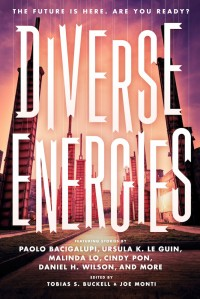Tobias S. Buckell's Blog, page 59
June 11, 2013
Diverse Energies a Bank Street College Best Book of the Year

I just learned, via contributor Malinda Lo, that the anthology of diverse YA fiction I edited with Joe Monti is a Bank Street College Best Book of the Year (in the anthologies category).
“Last fall, the anthology Diverse Energies, edited by Tobias Buckell and Joe Monti, included my short story ‘Good Girl.’ I recently learned that Diverse Energies has been selected as a Bank Street College Best Book of the Year in the Anthologies category (download PDF for full list). Yay! Congrats to the edito...
Sam Neill is funny about science

Ladies and gentlemen, Sam Neill (readers point out this site is a satire site, I just didn’t realize it wasn’t actually Neill that wrote this. I’m assuming Sam Neill said something stupid about science, then, and this was the result. Still hilarious dry wit, so kudos to whoever wrote it!):
“…as my career ascended so too did the value of the new things I learned. When I filmed The Hunt for Red October, I was amazed to discover that beneath the water there was a whole other area known as ‘under’water. What I didn’t know then was that we had this ‘under’water thanks to something called science. At the time I asked Sean Connery if he knew anything about science, but I was unable to understand anything he said, as he is Scottish.”
(Via Opinion: I’m not a scientist, but allow me to say a few things about science.)
Royalties and hardcovers and books, oh my!
In which someone is really mad about this:
“Look at Harper’s own numbers:
$27.99 hardcover generates $5.67 profit to publisher and $4.20 royalty to author
$14.99 agency priced e-book generates $7.87 profit to publisher and $2.62 royalty to author.
So, in other words, at these average price points, every time a hardcover sale is replaced by an e-book sale, the publisher makes $2.20 more per copy and the author makes $1.58 less. If the author made the same $4.20 royalty on the e-book sale as he/she would have on a hardcover, the publisher would STILL be making an improved profit of $6.28.”
(Via e-books and profitability– What we’ve always said and publishers have always denied | AARdvark.)
That’s interesting framing, though, as it assumes that hardcovers are the only form of large publishing.
So there are also these things called trade paperbacks (nominally $14.95) and mass market paperbacks (usually $7.99).
The royalty on those is not as lucrative as hardcovers. Not every author is ever even published in hardcover, either.
Additionally, if you look around, you’ll find that what is happening is that eBooks are eating into paper.
If I’m published only in hardcover (if you’re in hardcover, often you’re put out in paperback a while later, by the way) this is clearly an issue.
But normally eBooks eat into the *paperback.* So if I’m paperback only and make, say 10% on paperback (that’s not the case but it makes my math easier), that’s actually 79 cents per sale print, and $1.39 through the agency deal.
So this is why this is all complicated and there are no easy answers, because it’s all about the individual formula.
One author who comes out in hardcover first, and then paperback a year later, might worry about eBook sales. Are eBooks eating into hardcover sales? Will that price differential hurt them?
But once it’s out in paperback, the eBook sales are going to net more.
For an author coming out in paperback only, the eBook sales are going to be more lucrative.
From what I’ve seen for my career, it looks like hardcovers still sell, and that eBooks are taking over the price-conscious mass market area. Thus, the outrage above fails to make math sense.
If I were only published in hardcover, though I’ve never heard of anyone who is, I guess one would be very worried.
Usually authors who come out only in hardcover have a hardcover that’s selling so damn well everyone is thrilled about just leaving it up as a hardcover as long as they can.
Even then, they eventually transition.
If you think of eBooks as the 21st century paperback, though, it’s a useful rule of thumb.
addendum: a reader writes “the focus is more on the fact that the publishers are making more money in this deal, and that writers should try to squeeze more out of them.”
My thoughts: well, yes. They do make more. So everyone is making more (except book distributors and book stores, who are the losers in this arrangement). In capitalistic circles that’s often called ‘win-win’ and business look favorably at it. Does that mean there’s room in future negotiation? Yeah, of course. It’s a major bullet point of a whole article I wrote called “5 things I expect to see change about publishing” in point #2. I think stepped digital clauses will be the way to create win-win contracts that address this for both parties.
Additionally, John Green has thoughts on the idea that the author should get MORE MORE MORE at any costs here. I don’t fully agree with him, I think self publishing digitally/direct serves a function. But I think the obsession with 70% some people have with getting the whole digital pie obscures them to the fact that in some cases (not all), if not many, getting 70% of X is cool, but if a publisher gets you to X times a whole lot more, you may make more that way. Again, the author needs to figure out how the plug into that equation.
Again, I’m constantly having to point out that it’s just not so dead simple and there are a lot of misinformation flying around.
Hurricane Fever… so close to done
I’m knee deep in working on Hurricane Fever, the book that follows Arctic Rising. It’s hit that ‘near the end’ point where I’m finding it hard to keep up with email, uninterested in the outside world, eating food that’s bad to me, and wishing I were in a cabin somewhere secluded from the rest of the human race so that I could just finish this last stretch and have a complete draft already…
Geo-tagged tweets make for great maps

Cool!
“Twitter has compiled a series of maps showing geo-located Tweet volumes since 2009. The resulting maps are intricate, gorgeous — and even a bit revealing.”
(Via These stunning maps were made entirely from geotagged tweets.)
June 9, 2013
What the Antarctica under the ice looks like

Putting a pin in this to come back to later. An amazing map of what the ground under Antarctica looks like!
“Antarctica’s mountains, concealed for more than 30 million years under miles of ice, have now been exposed in a new map and video released June 5 by NASA. Using a new tool created by the British Antarctic Survey (BAS) called Bedmap2, researchers created the map by compiling decades worth of geophysical measurements of the icy continent, including surface elevation, ice thickness, an bedrock topography. ”
(Via “After 30 Million Years” –This is How Will Antarctica Look Without Ice.)
Is the US a place you must now flee?
I find this to be quite troubling:
“Americans are familiar with stories of dissidents fleeing repressive regimes such as those in China or Iran and seeking asylum in the United States. Snowden is in the opposite position. He’s an American leaving the land of his birth because he fears persecution.
Four decades ago, Daniel Ellsberg surrendered to federal authorities to face charges of violating the Espionage Act. During his trial, he was allowed to go free on bail, giving him a chance to explain his actions to the media. His case was eventually thrown out after it was revealed that the government had wiretapped him illegally.
Bradley Manning, a soldier who released classified documents to WikiLeaks in 2010, has had a very different experience. Manning was held for three years without trial, including 11 months when he was held in de facto solitary confinement. During some of this period, he was forced to sleep naked at night, allegedly as a way to prevent him from committing suicide. The United Nations’ special rapporteur on torture has condemned this as ‘cruel, inhuman and degrading treatment in violation of Article 16 of the convention against torture.’”
(Via Has the United States become the type of nation from which you have to seek asylum?.)
There used to be a tongue in cheek statement made by some people who would critique US policy and be told by people to leave the country. They’d say “Yeah, but I’d rather suffer American domestic policy than American foreign policy.”
In some cases, the two are now lining up…
Two 1-in-100 to 1-in-500 year floods in eleven years is a bit suspicious
Central Europe taking a global warming hit (link via ):
“If it seems like getting two 1-in-100 to 1-in-500 year floods in eleven years is a bit suspicious–well, it is. Those recurrence intervals are based on weather statistics from Earth’s former climate. We are now in a new climate regime with more heat and moisture in the atmosphere, combined with altered jet stream patterns, which makes major flooding disasters more likely in certain parts of the world, like Central Europe. As I discussed in a March 2013 post, ‘Are atmospheric flow patterns favorable for summer extreme weather increasing?’, research published this year by scientists at the Potsdam Institute for Climate Impact Research (PIK) in German found that extreme summertime jet stream patterns had become twice as common during 2001 – 2012 compared to the previous 22 years.”
June 8, 2013
How a small red-state city become a leader of transit in the US
This is really important to pay attention to:
“Once Salt Lake City leaders knew what people wanted, they embarked on a public relations campaign. Dee Allsop of the communications firm Heart and Mind Strategies led the effort.
‘How is it that the most conservative state… how is it they’re one of the most progressive in the country on transit?’ said Allsop. ‘It’s because the case was made in a way that fit with people’s values.’
The values they settled on were to have a city that was ‘beautiful, prosperous and neighborly.’”
(Via Salt Lake City: How a Remote Red-State City Became a Transit Leader | Streetsblog Capitol Hill.)
Continuum GoH Speech | Epiphany 2.0
N.K. Jemisin’s speech at Continuum is pretty damn amazing:
“And here’s the thing: women have been in SFF from the very beginning. We might not always have been visible, hidden away behind initials and masculine-sounding pseudonyms, quietly running the conventions at which men ran around pinching women’s bottoms, but we were there. And people of color have been in SFF from the very beginning, hiding behind the racial anonymity of names and pseudonyms — and sometimes forcibly prevented from publishing our work by well-meaning editors, lest SFF audiences be troubled by the sight of a brown person in the protagonist’s role.”



